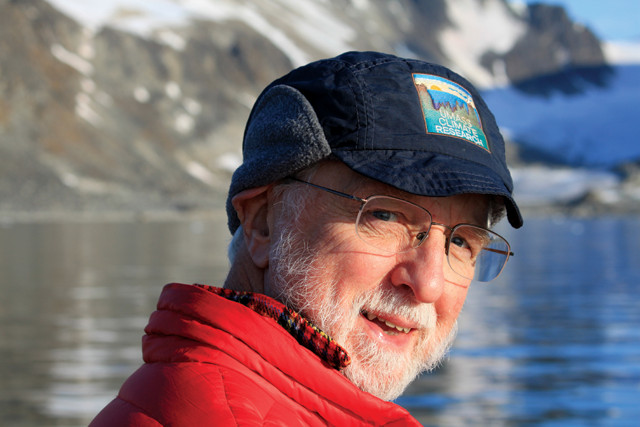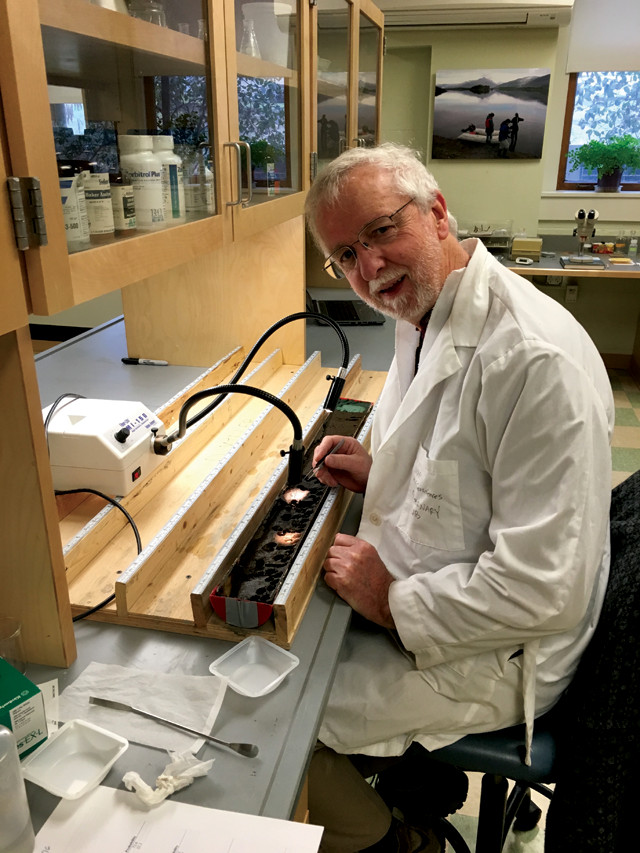
by Kate S. Zalzal Tuesday, December 27, 2016

Bradley on one of his many trips to the Arctic. Credit: Raymond S. Bradley.
When 21-year-old Raymond S. Bradley left England in 1969 to pursue a graduate degree at the University of Colorado Boulder (CU), he thought he’d be studying Denver’s urban climate. But on arrival, a funding mix-up delayed the work and Bradley found himself in search of a new project. While his doctoral work would ultimately involve studying the precipitation history of the Rockies, a new opportunity came his way in the summer of 1970 when his officemate needed a field assistant for a trip to the Arctic. So, Bradley headed to Baffin Island in the Canadian Arctic on a three-month excursion that would prove to be just the first of dozens of Arctic expeditions to come over the course of a distinguished career.

Raymond S. Bradley is the director of the Climate System Research Center and a University Distinguished Professor in the geoscience department at the University of Massachusetts Amherst. Credit: Raymond S. Bradley.
Today, Bradley is the director of the Climate System Research Center and a University Distinguished Professor in the geoscience department at the University of Massachusetts Amherst (UMass), where he’s been a faculty member since 1973. Bradley investigates climate variability and its causes across a range of Holocene timescales. He has studied instrumental data and developed proxy-based environmental reconstructions around the world, including from lake sediments in the Arctic, loess in China, glaciers in Beringia, and meteorological data from Kilimanjaro.
Bradley pioneered the development of standardized global temperature records — data that were foundational to the burgeoning awareness of climate change in the 1980s and ‘90s. He was also involved in groundbreaking work that looked to the paleoclimate record to put the current climate variability in perspective. This research produced the original, embattled “hockey-stick” graph — which showed that late-20th-century warming was unprecedented in the last 1,000 years — and ultimately propelled Bradley to the forefront of the contentious climate debate at the time. His work would later feature prominently in the Intergovernmental Panel on Climate Change (IPCC) Third Assessment Report published in 2001.
The summer of 2016 again found Bradley in the Arctic. This time, he was coring lakes near Viking settlements in southern Greenland, hoping to determine if climate really was the culprit that brought down these communities about 1,000 years ago.
Bradley recently spoke with EARTH editorial intern — and his former master’s student — Kate S. Zalzal, about his adventures in the Arctic, how climate science has evolved, and his thoughts about the future.
KSZ: How did you become interested in climatology?
RSB: I grew up in Ellesmere Port, England, on the River Mersey, across from Liverpool. I was always interested in earth science as a kid. I collected rocks and I started a weather station at my school. At Southampton University, I took a course from Roger Barry and became interested in urban climate, looking at how cities modify climate. He left and eventually took a job in Boulder, Colo., and I came too. But the funding fell through and I was left scratching around for a research project. Jack Ives had a project looking at the impact of cloud seeding on the environment. They wanted to increase snowpack over the San Juan Mountains in southern Colorado by putting silver iodide in the clouds. But there was a lot of concern about what the impact would be on elk, avalanches and the ecosystem in the region. I was given the job of trying to find out what the natural variability of snowfall was in that region. I started delving into long historical records and I found these historic records from the forts that were established across the West in the 19th century. My doctoral thesis developed from that.
KSZ: When did you begin working in the Arctic?__

Bradley in his lab at UMass. Credit: Raymond S. Bradley
__RSB: __In the course of my graduate work at CU, I was sharing an office with Bob Dugdale; he was working with John Andrews on a master’s project on Baffin Island and they needed another field assistant. So I went to Baffin Island in 1970 — my first trip to the Arctic. It was a tough experience — there wasn’t enough funding to support the project. We were there for three months, collectively we must have lost about 100 kilograms in weight. It turned out, of course, that it was a great experience — although at the time we didn’t think so. We all came back and said, “I’m never going to the Arctic again.” Within a month, we were plotting how to get back.
The following year I went to northern Ellesmere Island with John England as a field assistant and it was just a magical experience. In 1972, I went to Baffin Island with John Jacobs and another guy and we camped on the shore of Broughton Island, along the east coast. We were measuring energy balances as the sea ice broke up. It’s crazy when I look back on it — we were just sitting in a tent right there all summer in polar bear alley. It was ridiculous, but we survived. Then I got a job at UMass in 1973 and received a National Science Foundation grant to go back to Ellesmere Island. I just kept going back since then.
KSZ: Where have you been doing fieldwork recently____
____RSB: __I went up to Svalbard, Norway, several years ago and sailed up the coast on a boat and did some coring in lakes along the coast. A few years later, we went around the north coast, and that was a fantastic experience. I felt like a real explorer. KSZ: What was so exciting about that trip?
RSB: __You’re on a boat, a sailing ship, thrashing through the waves. You just feel like you’re really doing this the way it was done in the past. It was a comfortable ship, but it’s still scary — there’s ice around, it gets really dark at night. We went right up around where Dutch whalers in the 1600s had hunted whales from little wooden ships. They had a settlement called Smeerenburg where they dragged whales ashore and cut them up. We also went across the strait to the place where three Swedes had launched a hydrogen balloon and tried to sail it to the North Pole. They flew off and disappeared into the wild blue yonder; no one knew what happened. Thirty years later, their bodies were found on an island in the northwest part of Svalbard. In their camp on the shore was a camera, and [the finders] took the film to develop it. There is this whole photographic archive of what happened to [the balloonists]. Here we were sailing past all these historic places. It was just really exciting.
KSZ: When did the issue of climate change come onto your radar?____
______RSB: ______In the early 1980s, I, along with others, got funding from the Department of Energy to create a record of the last 100 years of temperature from worldwide instrumental records. We tried to get all the instrumental records from around the world, standardize them and get them on the same timescale. Eventually we produced this fairly reliable record of temperature and we published it in the mid-1980s. Once we’d done that, we said: “OK, how does this compare to records from previous centuries?” So we looked at proxy data to put it in perspective. I went to a wine tasting with a friend and got connected with Michael Mann, now at Penn State. He came to UMass for a two-year fellowship and he brought a lot of mathematical expertise. We became a lot more quantitative about how we did the reconstruction, and that led to the hockey-stick graph and the eventual controversy.
KSZ: How have your research questions evolved?____
RSB: Lately, I’ve been interested in sea-level change, archaeology and the exploration of the North Atlantic. I’ve been working in northwestern Norway, in the Lofoten Islands, looking at organic biomarkers as indicators of human occupancy and biomass burning, as well as alkane chain lengths related to vegetation — indicators of how the landscape may have changed.
I have also been exploring Denmark’s Faroe Islands — the islands between Iceland and Scotland. The Faroes are right at a climatic gradient in the North Atlantic so the islands themselves are quite sensitive to changes in North Atlantic circulation. I read an article that said the Vikings were not the first people to arrive, it may have been Celtic monks, so I applied for and received some funding from National Geographic and we went to the Faroes to core lakes. People have seen changes in the pollen records that they ascribe to climate. But there’s obviously a human overprint in the record. We’re trying to decipher the human impact from the natural climate variations. Can we separate these out? The story came together nicely in Norway, but it’s been much harder in the Faroes. So now we’re going with DNA, trying to find DNA there that is related to the arrival of people and animals. There were no mammals on the Faroes until people arrived, so there should be a good signal there.

Bradley and his students, including Greg de Wet, have cored lakes near the southern Greenland community of Gardar. Credit: both: Raymond S. Bradley.
KSZ: Are you optimistic about our ability to combat climate change?__
RSB: __The ball is now in the court of economists and social scientists in the sense that all the solutions to climate change are political and socioeconomic. There is also an urgent need to figure out instruments that can suck carbon dioxide out of the air, and to produce better batteries — all those sorts of technological solutions. I’m a technological optimist. I think the technology is moving fast and we’re on the cusp of dramatic transformations.
KSZ: What has been your favorite part of your career?____
______RSB: ____It’s been the opportunity to visit amazing places. I hope to continue that for a few more years. KSZ: Do you have any advice for future scientists?
RSB: __Try to pursue what your main interests are; that means you’ll do it well, you’ll do it enthusiastically, and you will enjoy it. Keep your eye on the ball and try not to be distracted by all the other things. Use your time wisely. Time is our most important commodity. You need good computational skills too.
KSZ: Where will your next trip take you?____
______RSB: ______I’m heading back to Greenland in the summer of 2017. We’ll see about the Faroes and Lofotens.
© 2008-2021. All rights reserved. Any copying, redistribution or retransmission of any of the contents of this service without the expressed written permission of the American Geosciences Institute is expressly prohibited. Click here for all copyright requests.